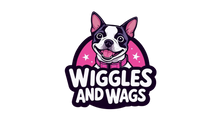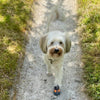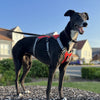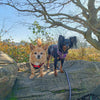How To Measure My Dog For a Harness
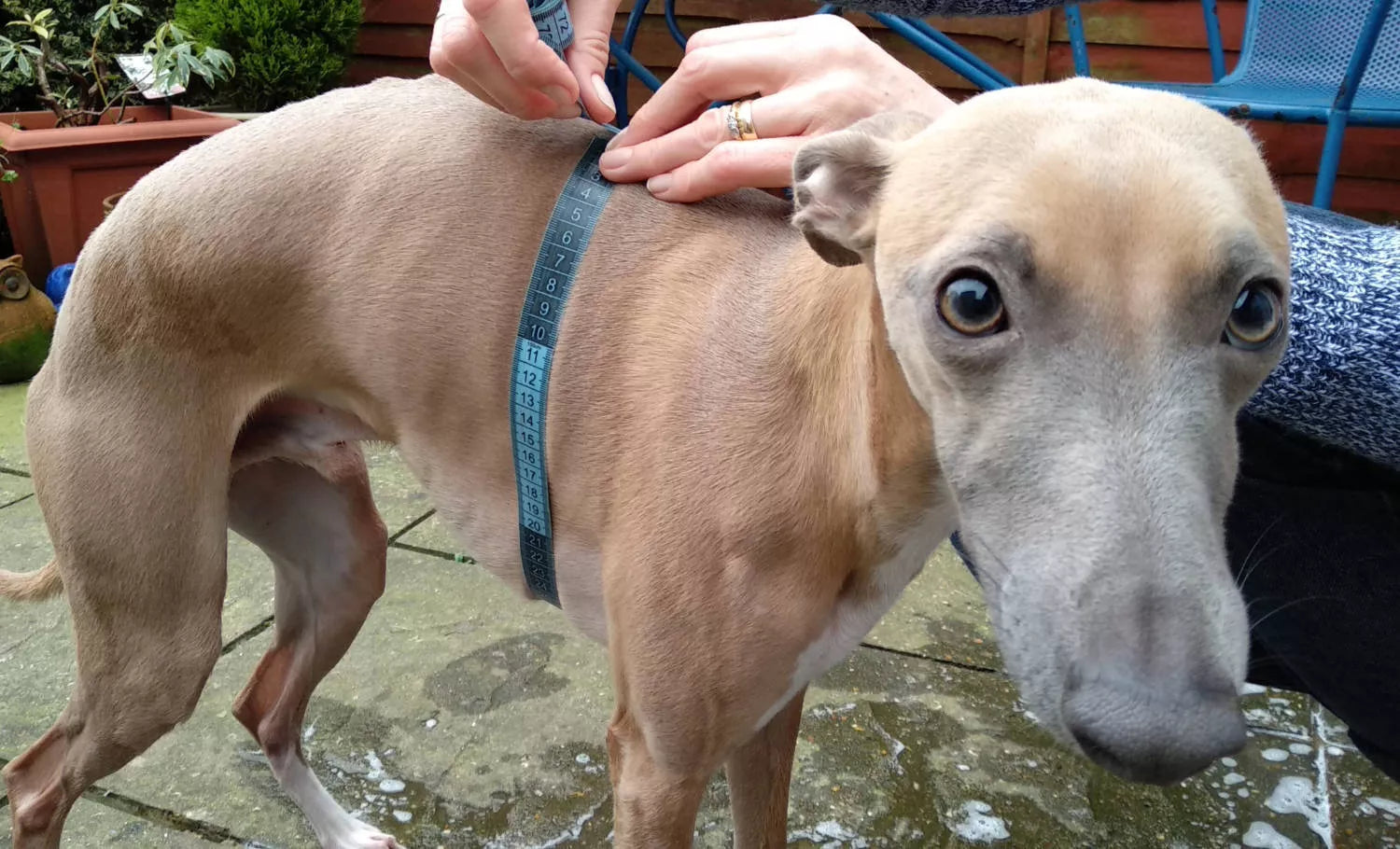
This is one of the most common questions with dog owners and you'll be pleased to know that measuring your dog for a harness is a very simple process. That said, it is surprising how many owners there are out there who do not do it at all. Instead, they are quite happy to guess the size of a harness by basing it on past purchase history or size guides which mention breed sizes and weights. Our advise to you is that you should always measure your dog before buying a harness. Also, it is best not to assume that just because your dog is tiny or huge you'll need the smallest or largest harness in the range.
When we see people at UK dog shows, most will point to their dog and say "so what size harness do you think we need." More often than not, we'll take one look at the dog and get it just about right - even down to the altering of straps before we fit it. This comes with fitting hundreds of harnesses on many different breeds and it is something we have learnt over the years.
Dogs vary in size, shape, height and length. Some will have deep chests, some will be slight with small or large necks that do not always look in proportion to their main body. You should take all of this into consideration when you measure your dog for a harness.
A harness will usually fasten around the neck area to secure it and give it stability at the front - there will then be another fastening point around the body, behind the front legs. This gives an area to secure the harness at two points, both in front and behind the front legs. This means that if the dog pulls you forward when you are behind it, the harness will push onto the lower part of the chest. If the dog pulls you back when you are in front of it, the front legs should stop the harness from coming away from the dog's body. By making subtle adjustments to the neck and main body, you'll ensure that the harness is stable and will stay on your dog.
Once you have this measurement in cms and inches, make a note of it and refer to the table or size guide on the product website or label. Make sure you choose a harness that falls within this measurement. If your measurement is on the upper limit, bear this in mind when you take measurement two around the chest/rib cage.
Run the tape around the girth of the chest/rib cage just behind the front legs and make a note of this measurement. Now check the website size guide or label and match it to the harness that falls within this measurement. If you are at the upper limit of one size it may be better to go for the next size up. To make this decision easier, take another look at your first measurement for the neck.
If both the neck and chest measurements are on the upper limit, then go for the next size. If you have plenty of room to spare on the chest but not much on the neck then you may want to stick with that size. If your measurements for both neck and chest have plenty of room to spare then you should be very safe.
However, if you have a dog with a deep chest or one that bulges out the front, you may want to allow for a bit more room around the chest.
Please remember that harnesses which fit around the front part of the body will normally have a strap that comes close to the pit of the front legs. You should adjust the harness so that this does not push into the pit. The straps should be vertically aligned or go in a backward direction away from the front legs.
If the straps are in a forward direction, (going into the pit) then the neck is too tight or the harness is just too small. Buying a larger harness or opening the harness out (if it will allow it) should bring the fastening straps away from the front legs a bit, so when your dog walks there is no chafing.
Final points
Most harnesses have a lot of adjustment built in and can normally be made to fit based on correctly measuring and matching the harness on a size guide. If you take a bit of time to measure your dog you should get one to fit it. If you have any questions or queries about buying a harness, please call or email us.
When we see people at UK dog shows, most will point to their dog and say "so what size harness do you think we need." More often than not, we'll take one look at the dog and get it just about right - even down to the altering of straps before we fit it. This comes with fitting hundreds of harnesses on many different breeds and it is something we have learnt over the years.
Dogs vary in size, shape, height and length. Some will have deep chests, some will be slight with small or large necks that do not always look in proportion to their main body. You should take all of this into consideration when you measure your dog for a harness.
How does a harness stay on?
Most manufacturers will offer smallest and largest settings (levels of adjustment) for their harnesses. This could be for a strap around the front part, middle and rear of the dog, but there are most likely two main areas of adjustment - these are around the neck and around the front part of the chest or rib cage.A harness will usually fasten around the neck area to secure it and give it stability at the front - there will then be another fastening point around the body, behind the front legs. This gives an area to secure the harness at two points, both in front and behind the front legs. This means that if the dog pulls you forward when you are behind it, the harness will push onto the lower part of the chest. If the dog pulls you back when you are in front of it, the front legs should stop the harness from coming away from the dog's body. By making subtle adjustments to the neck and main body, you'll ensure that the harness is stable and will stay on your dog.
Taking your dog's neck measurement
On most harnesses, there will be a strap, plate or padded area that will go over and/or fasten around the neck. To get the best fitting harness, you'll need to choose one that will have a level of adjustment to fall within this measurement. To begin, just run a tape around your dog's neck so you are measuring the girth (circumference) of the neck. You should allow a little bit of room so make sure the tape is not too tight. Allow for the length of fur and for a fit which is normal for a dog collar - image that the tape is your dog collar and fit it as you would like your collar to fit.Once you have this measurement in cms and inches, make a note of it and refer to the table or size guide on the product website or label. Make sure you choose a harness that falls within this measurement. If your measurement is on the upper limit, bear this in mind when you take measurement two around the chest/rib cage.
Measuring your dog's chest and rib cage
This measurement should be taken around the chest/rib cage area which is just behind the front legs. This is where many harnesses will include a strap and/or fastening to secure the harness around the front torso.Run the tape around the girth of the chest/rib cage just behind the front legs and make a note of this measurement. Now check the website size guide or label and match it to the harness that falls within this measurement. If you are at the upper limit of one size it may be better to go for the next size up. To make this decision easier, take another look at your first measurement for the neck.
If both the neck and chest measurements are on the upper limit, then go for the next size. If you have plenty of room to spare on the chest but not much on the neck then you may want to stick with that size. If your measurements for both neck and chest have plenty of room to spare then you should be very safe.
However, if you have a dog with a deep chest or one that bulges out the front, you may want to allow for a bit more room around the chest.
If your dog pulls
If your dog pulls like a train, then you may opt for a no pull harness This type of harness will usually have a lead fastening ring at the top and front of the harness. The one at the top is for braking and the one at the front is used to apply a subtle steering action. The steering action will move the front of the harness up to the left or right hand side. Please bear in mind that the looser you have the neck, the more this area will move. You should play around with the adjustment on the neck and straps until you have the right fit.Please remember that harnesses which fit around the front part of the body will normally have a strap that comes close to the pit of the front legs. You should adjust the harness so that this does not push into the pit. The straps should be vertically aligned or go in a backward direction away from the front legs.
If the straps are in a forward direction, (going into the pit) then the neck is too tight or the harness is just too small. Buying a larger harness or opening the harness out (if it will allow it) should bring the fastening straps away from the front legs a bit, so when your dog walks there is no chafing.
Final points
Most harnesses have a lot of adjustment built in and can normally be made to fit based on correctly measuring and matching the harness on a size guide. If you take a bit of time to measure your dog you should get one to fit it. If you have any questions or queries about buying a harness, please call or email us.
